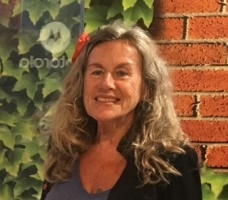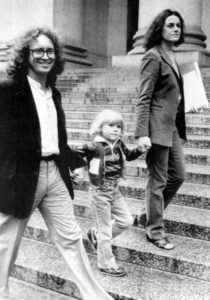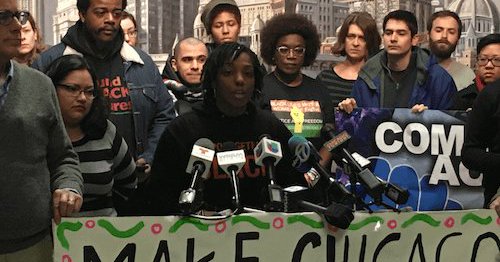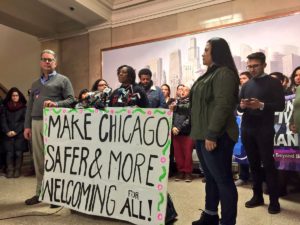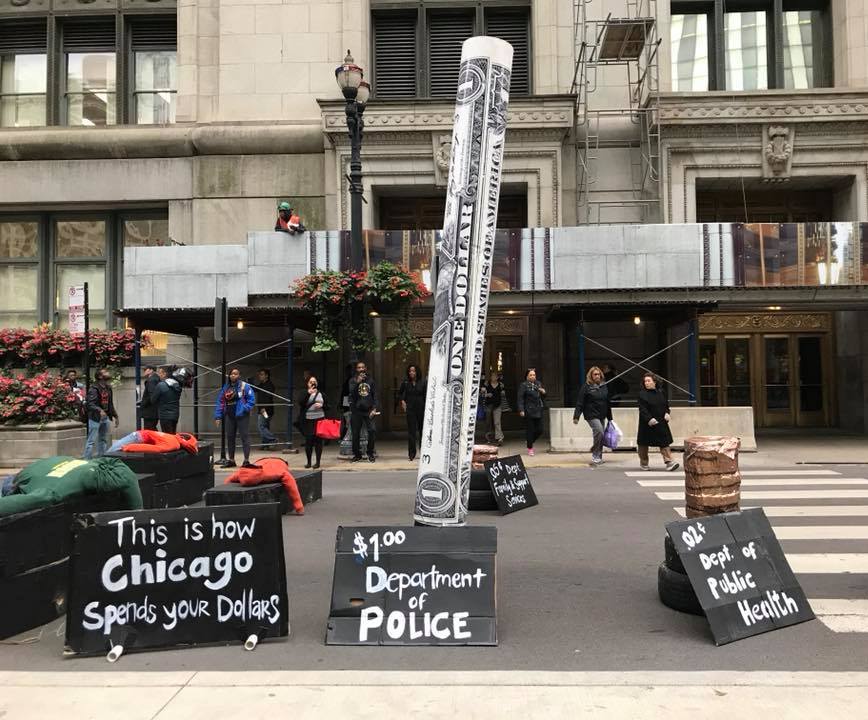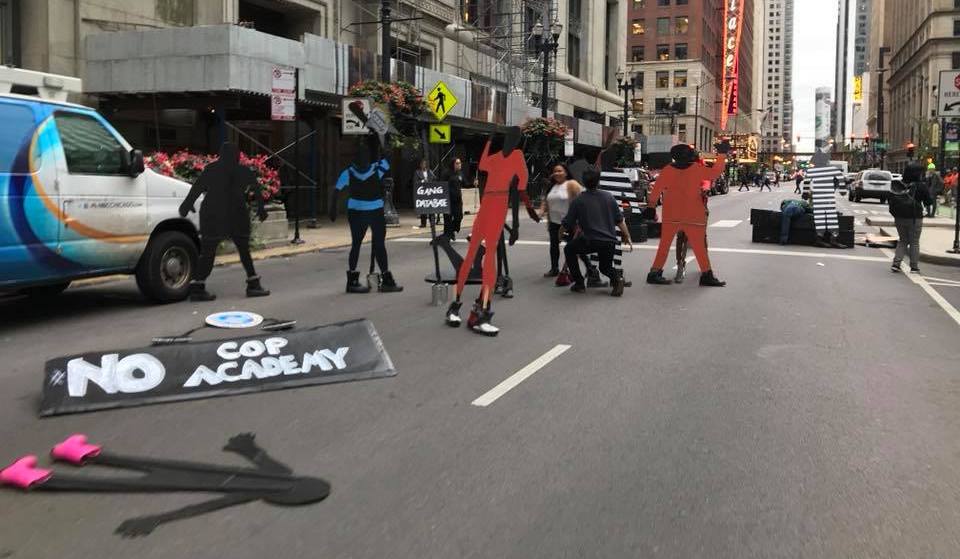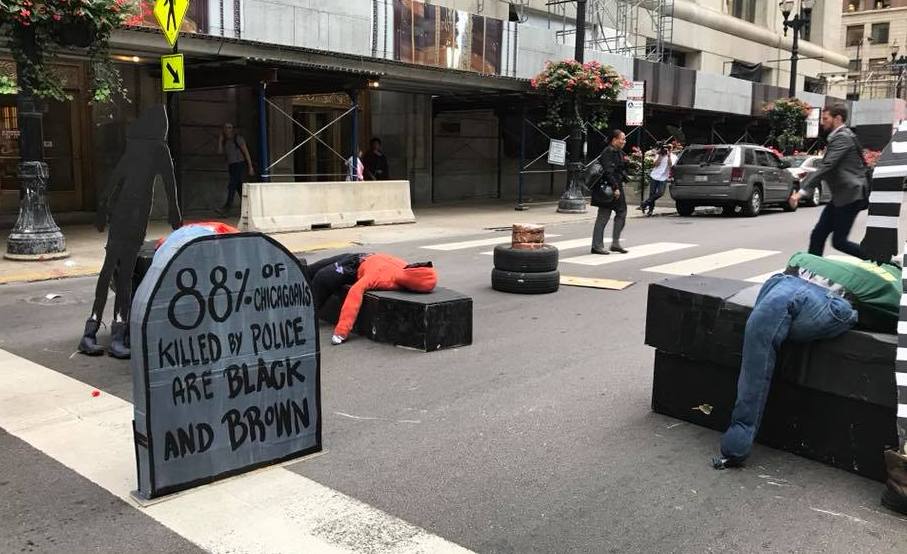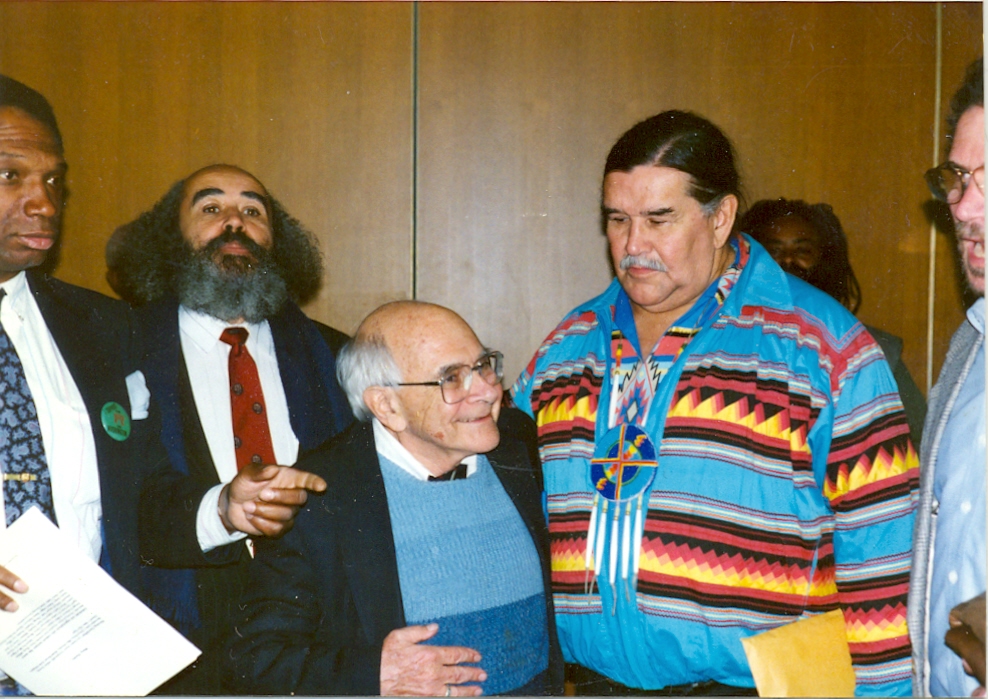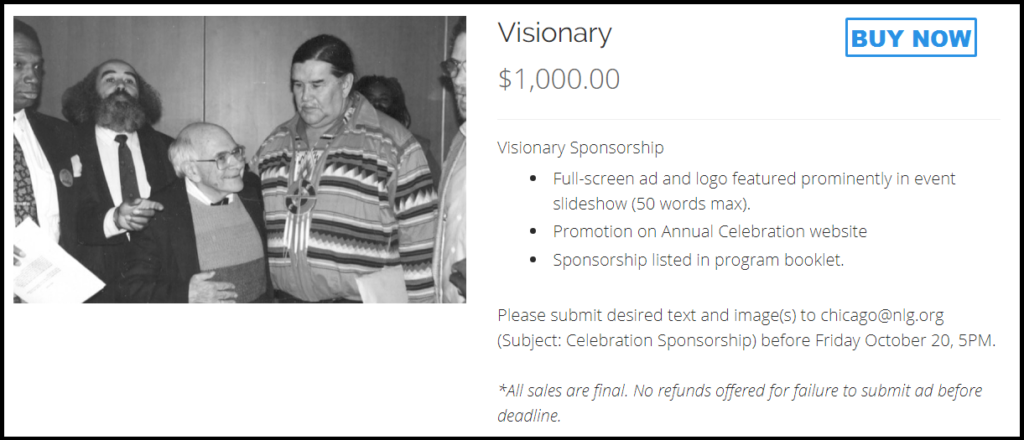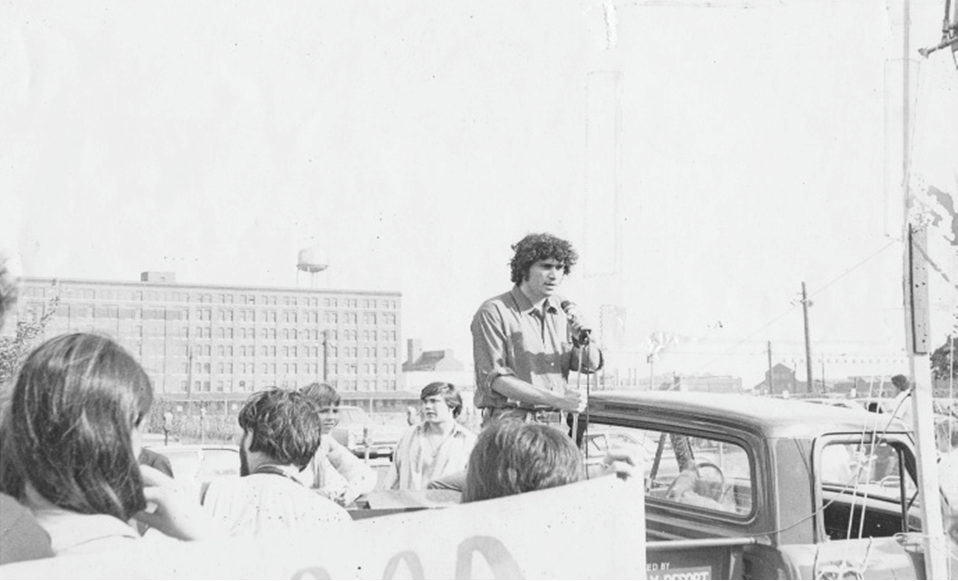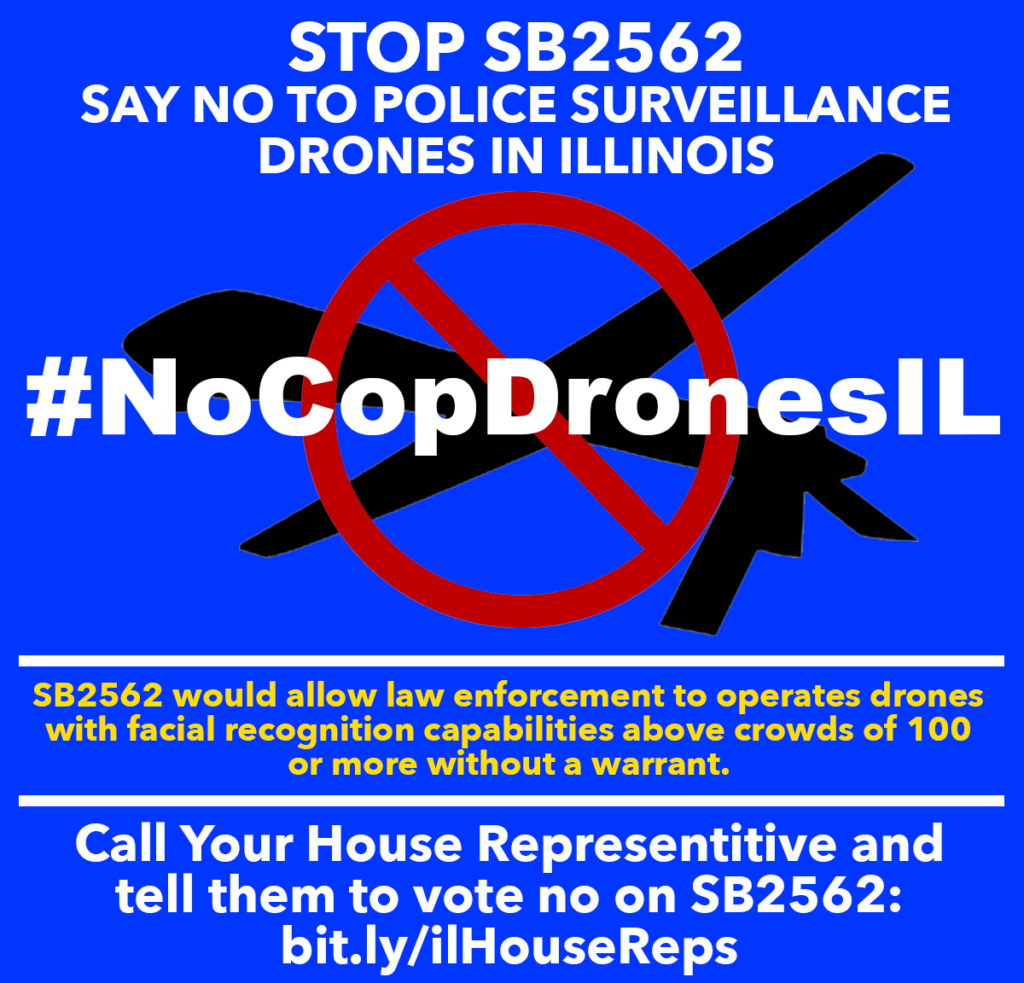
We the undersigned organizations stand together in opposition to SB 2562. This bill would allow police to use drones equipped with facial recognition capabilities to spy on large public gatherings across the state of Illinois.
Increased surveillance of demonstrations and other public gatherings will make us all less safe because it intimidates and deters people from exercising their First Amendment right to protest, a necessary tool for holding elected officials accountable–especially in the age of Trump. If we want to build a more equitable world, the Illinois legislature must encourage political engagement, not scare our fellow Illinoisans away from its most elemental form: public gathering.
We are greatly troubled by the dramatic expansion of surveillance powers this bill would make available to Illinois law enforcement. The Chicago Police Department’s long history of violating the rights of protesters is well known and includes unlawful surveillance and targeted abuse of people working to make this a more just city for our most marginalized residents. Chicago police violence as exemplified by the police riot at the 1968 Democratic National Convention and the murder of Black Panther Party leader Fred Hampton in 1969 continues today. We need only look at the recent attempts by the Chicago police to interfere with protected First Amendment activity by the #BlackLivesMatter to be convinced that the Chicago police are not to be trusted with a legal tool that will allow them to invade personal privacy and impede political activity from the skies.
We strongly encourage elected officials to oppose SB 2562 and the widespread use of surveillance technology by police.
Signed,
A Just Harvest
ACLU Illinois
ACLU of Champaign County
American Friends Service Committee Chicago
Assata’s Daughters
Black and Pink – Chicago
Black Lives Matter – Chicago
BYP 100
The Chicago Alliance Against Racist and Political Repression
Chicago Community Bond Fund
Chicago District of the International Socialist Organization
C.L.A.W. – Chicago League of Abolitionist Whites
Gay Liberation Network
GoodKids MadCity
Organized Communities Against Deportations
People’s Response Team
People’s Law Office
SURJ – Showing Up for Racial Justice
Trinity United Church of Christ, Chicago
Urbana-Champaign Independent Media Center
Uptown People’s Law Center
Workers Center for Racial Justice
Current Status of SB 2562
On May 2nd, the Illinois Senate approved SB 2562. The bill passed out of committee in the House on May 17th. SB 2562 must now be presented three times in the House before it can be put up for a vote.
How Did We Get Here:
Currently, Illinois law only allows police to use drones if they have obtained a warrant, suspect a high risk of loss of life, are searching for a missing person, or are taking crime scene photos. citizens of Illinois are currently protected by the Biometric Information Privacy Act which prohibits most kind of facial recognition technology being applied to them, although these protections do not apply to police departments.
SB 2562 would dramatically increase the ability of law enforcement to surveil public gatherings and public gatherings. The bills were introduced in early 2018 by two legislators who are extremely-friendly to Rahm Emanuel’s policy agendas and both currently in committee. The ACLU of Illinois went as far as accusing Rahm Emanuel and his administration as secretly being behind the bill. The threshold for deploying drones could be very low: a “large-scale public event” of over 100 people or “if the United States Secretary of Homeland Security determines that credible intelligence indicates that there is that risk”.
Racial Bias and Facial Recognition Technology:
Facial Recognition is automated process by which computer algorithms compare unknown faces to a known database of previously collected images such as mug shots or driver license photos. First, a large data set of images must be collected and then an unknown image will be classified to return the probability of a match against a known image. It is estimated that the FBI’s FACE system has access to forty-three million faces from driver licence photos from the Illinois Secretary of State. An import assumptions of the training data is the faces are usually in well-controlled environment, with a face looking directly at a camera and with good lighting.
According to a report by the Center on Privacy & Technology at Georgetown Law, the use of facial recognition technology has several racial biases. After an analysis of the top three algorithms used by facial recognition “all three of the algorithms were 5 to 10% less accurate on African Americans than Caucasians”. There was also a “a similar decline surfaced for females as compared to males and younger subjects as compared to older subjects”. Furthermore, since facial recognition technology only returns the probability of a match and other similar faces, a person can come into contact with law enforcement for the actions of other individuals. This issue is exacerbated due to the racial discrepancy of interactions between minorities and law enforcement which leaks to an over-inclusion of minorities in facial recognition datasets.
A Troubling Trend
The Chicago Police have abused surveillance technology in recent history. Most recently, the department came under scrutiny for their use of Stingrays. Multiple lawsuits have challenged the lack of oversight and the use of Stingray technology to collect data from the phones of thousands of unsuspecting individuals attending protests. After it was discovered that Chicago Police were using Stingrays with minimal legal protections, the legislature passed a strong warrant requirement bill in 2016. Now, some members of the legislature are pushing to give police more access to surveillance technology despite the fact that state law already allows law enforcement use of drones in a genuine security crisis.
In a 2012 Senate hearing, Senator Al Franken, then Chairman of the Senate Subcommittee on Privacy, Technology and the Law, confronted the FBI about an agency PowerPoint presentation showing how face recognition could be used to identify people attending the 2008 presidential campaign rallies for then-senators Barack Obama and Hillary Clinton.150 In 2015, the FBI admitted that it conducted surveillance flights over Ferguson and Baltimore during protests of police use of force. The Department of Homeland Security has monitored Black Lives Matter protests. And footage of Chris Wilson’s protest shows an officer videotaping the event.
In Hassan v. City of New York, a 2015 case challenging the NYPD’s pervasive video, photographic, and undercover surveillance of Muslim Americans following 9/11,161 the Third Circuit agreed with the plaintiffs—the victims of surveillance—that the manner by which the program was administered—specifically targeting a group of people for their beliefs and religious affiliations—may have caused them “direct, ongoing, and immediate harm.” Hassan v. City of New York, 804 F.3d 277, 292 (3d Cir. 2015).
Surveillance Doesn’t Mean Accountability
While some argue that such technology can be used to hold police accountable, the proliferation of body cameras has shown the fallacy of this position. Police body cameras now allow us to watch the ongoing abuse of power in viral social media videos, yet have little impact on the consequences for police officers involved. In Washington DC, The Lab @ DC conducted a study on the Metropolitan Police Department’s use of Body Worn Cameras. That extensive study found that “body-worn cameras had no statistically significant effects on any of the measured outcomes.”
This was displayed quite clearly in the body camera footage of the Chicago Police murder of Paul O’Neal in July 2016. The fact that the officers were wearing body cams didn’t stop them from shooting 18-year-old O’Neal in the back or from high-fiving each other as he bled to death in a Southside backyard. More often than not, surveillance technology is used to criminalize the victims of police violence, not to hold the perpetrators of state violence accountable. Like body cams, new cameras on drones will be trained on civilians and not on the police themselves.
What You Can Do
- Get your organization to sign onto this statement by emailing chicago@nlg.org
- Law Students: sign the law student petition here.
- Contact your local House Representative and tell them you want them to oppose SB2562.
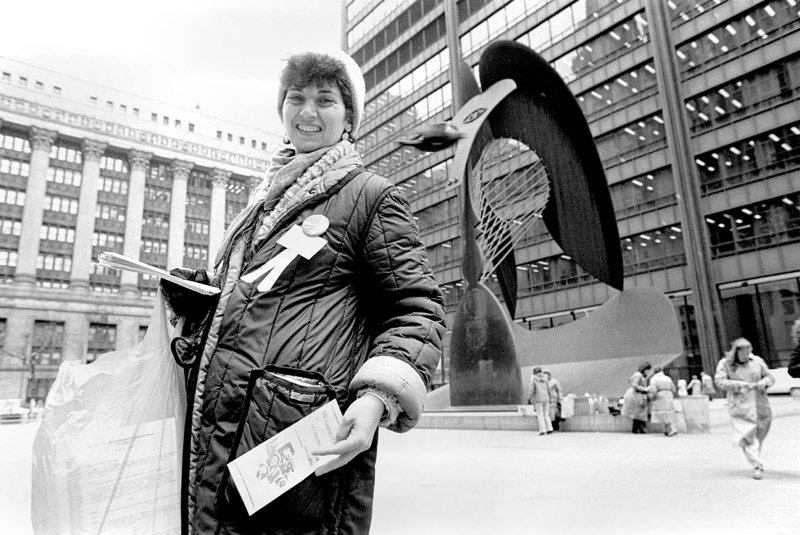
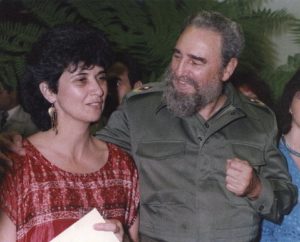 She left DePaul University in 1992, and joined the New York City law firm
She left DePaul University in 1992, and joined the New York City law firm 
